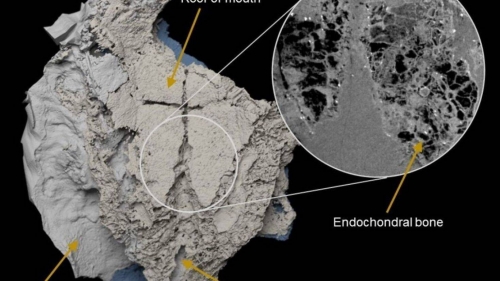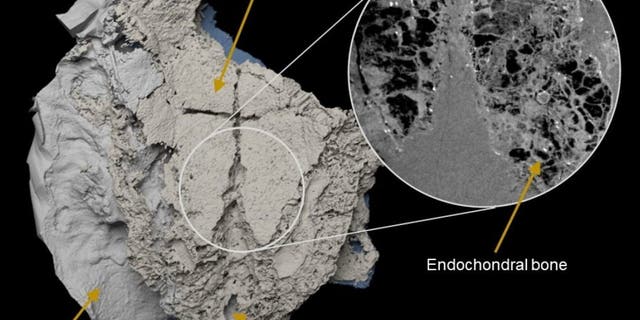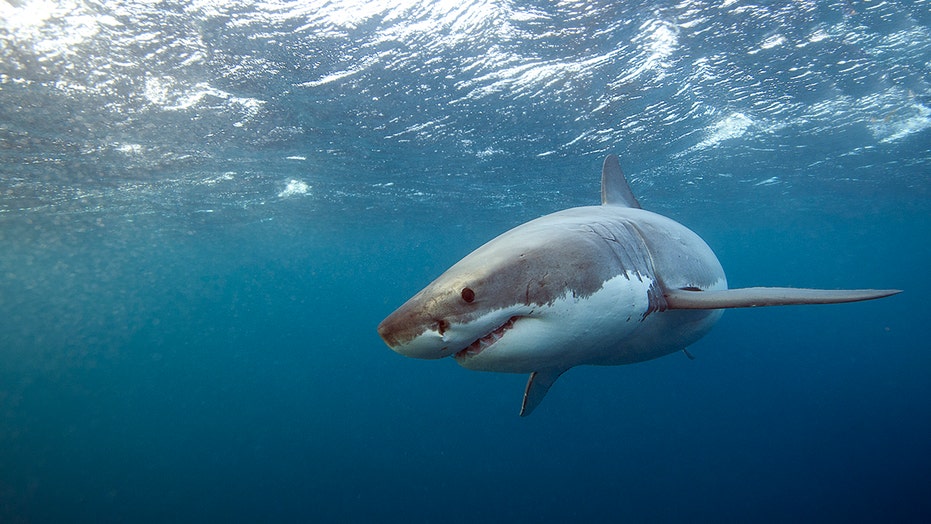profile/5434IMG_20200705_171151_6.jpg
Mrfiashnwa

400M-year-old 'armored' Fish May Change The History Of Sharks As We Know It
~2.4 mins read
A 410-million-year-old fossil of an armored fish has completely changed the history of sharks, according to a newly published study.
The fish, known as Minjinia turgenensis, had a skeleton made of bone, as opposed to the cartilage that sharks are largely comprised of now, save for their teeth. Experts discovered the fossilized skull in the Mongolian mountains.
“It was a very unexpected discovery," the study's lead author, Martin Brazeau, said in a statement. "Conventional wisdom says that a bony inner skeleton was a unique innovation of the lineage that split from the ancestor of sharks more than 400 million years ago, but here is clear evidence of bony inner skeleton in a cousin of both sharks and, ultimately, us.”

Virtual three-dimensional model of the braincase of Minjinia turgenensis generated from CT scan. Inset shows raw scan data showing the spongy endochondral bone inside. (Credit: Imperial College London)
It's possible that M. turgenensis could have been larger than great whites, with some members of the placoderm (jawed fish) species reaching 30 feet or more in length. Brazeau also noted it was likely a predator.
Although M. turgenensis is believed to have been significantly smaller than modern-day whale sharks or great whites at approximately 1 foot long, it has made an enormous impact, suggesting that sharks once had bone and then lost it, researchers said.
In addition to having a skeleton comprised of bone, it had bony plates over its head and shoulders that acted as shields, with Brazeau describing it as "extensive armor" as it swam the ancient seas.
The discovery adds further credence to the theory that endochondral bone – which makes up human skeletons after birth – may have played a huge role in shark evolution and helped them exist and adapt for more than 400 million years.
“If sharks had bony skeletons and lost it, it could be an evolutionary adaptation," Brazeau added. "Sharks don’t have swim bladders, which evolved later in bony fish, but a lighter skeleton would have helped them be more mobile in the water and swim at different depths.
“This may be what helped sharks to be one of the first global fish species, spreading out into oceans around the world 400 million years ago," Brazeau explained.
The study was published in the scientific journal Nature Ecology & Evolution.
profile/5434IMG_20200705_171151_6.jpg
Mrfiashnwa

THE 1 SCI-FI THRILLER YOU NEED TO WATCH BEFORE IT LEAVES NETFLIX THIS MONTH
~2.0 mins read
TO SAY 2020 HAS BEEN A YEAR OF DISASTERS is a cliche. It is also very true. Seven months into a pandemic and there's still that unshakable feeling that everything going wrong will only get worse. Which is why it's fun (?) to look back on times we thought disaster was imminent, and we made them into rollercoasters.
2012, a 2009 epic disaster movie from disaster movie extraordinaire Roland Emmerich, is an exceedingly dumb, exceedingly long, and exceedingly fun movie that riffed on the late 2000s paranoia of the Mayan calendar apocalypse. Yeah, remember that? Watching 2012 now in 2020 is a hell of a reminder of when our doomsday scenarios seemed both more dire and more innocent.
2012, with its all-star cast featuring John Cusack, Chiwetel Ejiofor, Woody Harrelson, Amanda Peet, Thandie Newton, Oliver Platt, and Danny Glover as a now-impossible-to-imagine capable and empathetic President of the United States, is the movie you need to watch on Netflix before it leaves at the end of September.
To describe 2012 is to describe insanity on its own terms. The movie takes the (wildly misinterpreted) Mayan calendar end date of December 21, 2012 as the inciting incident for the Earth's core to implode, causing violent tectonic shifts. That basically translates to "earthquakes, everywhere." Bridges fall, Yellowstone is engulfed in fire, and cities sink into the sea. At one point, sewage covers Cusack's getaway limo, a harsh metaphor for how the movie thinks of itself.
The film, like many of Emmerich's blockbusters, boasts an ensemble cast of characters who meet when the plot demands. But its two "main" protagonists are Adrian (Ejiofor), a geologist and chief advisor to the U.S. President, and Jackson Curtis (Cusack), a science fiction writer who is emotionally losing his kids to their stepfather. As Curtis races to get his family to safety alongside a Russian billionaire (!!??), Adrian attempts science to save humanity.
Look, it's all very silly. Not only because it's 2012 and no one has a smartphone, or that Cusack's kid plays a PSP. Or that Danny Glover's President exudes palpable dramatic weight you believe a sitting President would stay behind and not board a billion-dollar ship I'm calling "Noah's Ark Force One." At this very moment on my personal Facebook, a friend from college is refusing to believe Trump could say that fallen veterans are "losers." 2012 is a ridiculous fantasy not because of the disastrous earthquakes but because it has a President who takes the job seriously.
Advertisement

Link socials
Matches
Loading...

 Video
Video